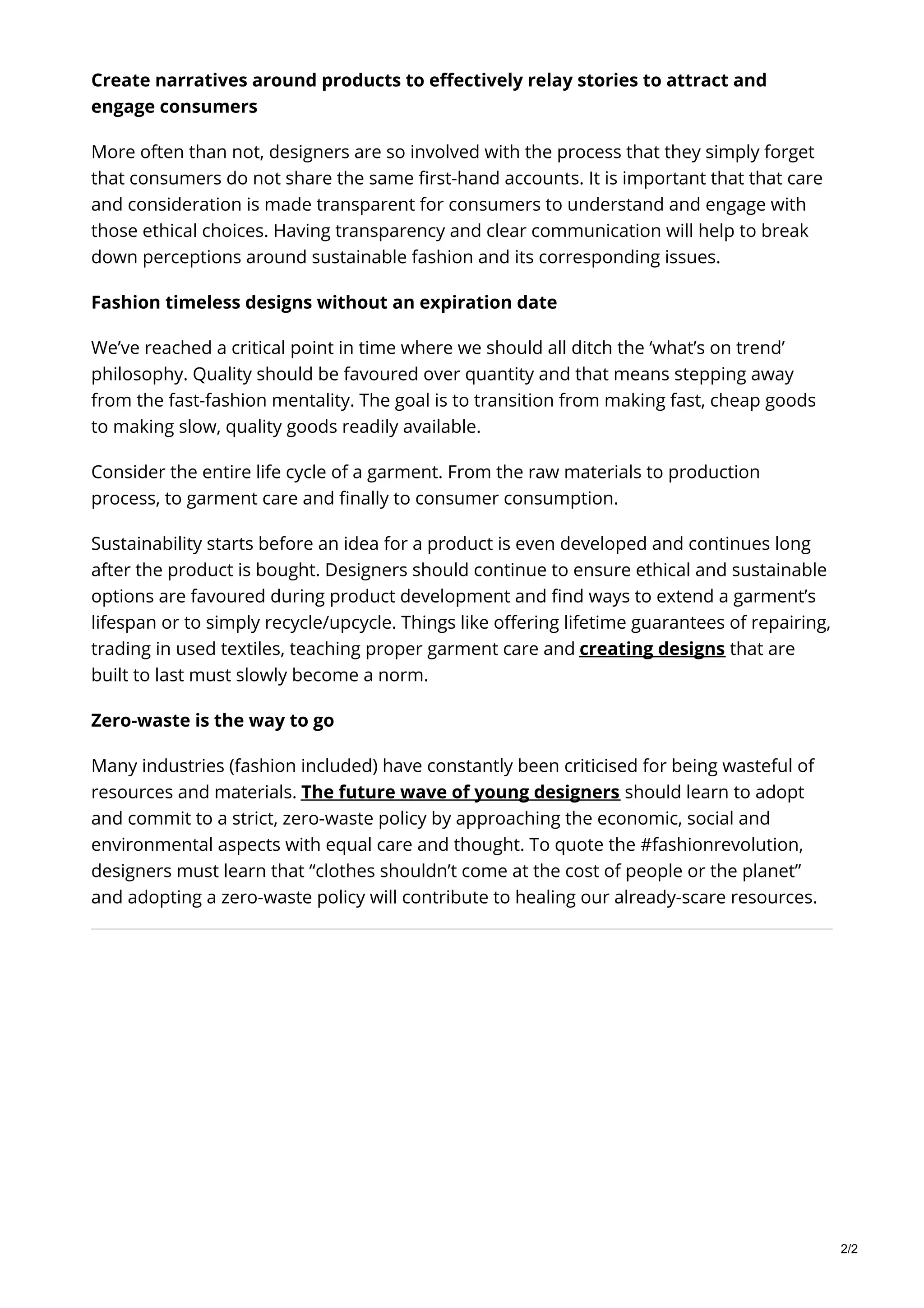World Updates | Update information about politics and social around the world
Maria Verdoy: A Pioneer In Sustainable Fashion Design
After a thoughtful analysis of the data we've gathered, and in light of her dedication to this field, we're excited to share our comprehensive guide on Maria Verdoy and her pioneering contributions to sustainable fashion.
| Key Differences | Key Takeaways |
|---|---|
| Sustainable Materials | Natural, biodegradable fabrics reduce environmental impact. |
| Ethical Manufacturing | Fair labor practices and safe working conditions ensure worker well-being. |
| Transparency | Clear communication about production processes fosters trust and accountability. |
As we delve deeper into Maria Verdoy: A Pioneer In Sustainable Fashion Design, we will explore the many ways in which she has revolutionized this industry and continues to shape its future.
Maria Verdoy was an extraordinary pioneer in sustainable fashion design whose influence continues to shape the industry today.

Redress to impress: Christina Dean on sustainable Fashion - Source www.prestigeonline.com
Editor's Notes: "Maria Verdoy: A Pioneer In Sustainable Fashion Design" have published . As the world grapples with the environmental impact of fast fashion, Verdoy's work is more relevant than ever, inspiring designers and consumers alike to embrace sustainable practices. To help our readers understand the significance of her contributions, we have analyzed her work and compiled this guide to sustainable fashion design.
We made an effort to dig information and put together this guide to help our reader make the right decision.
Key differences or Key takeways:
| Aspect | Maria Verdoy's approach |
|---|---|
| Materials | Focused on natural, organic, and biodegradable fibers such as hemp, organic cotton, and bamboo. |
| Production | Emphasized ethical practices, fair labor conditions, and minimal waste throughout the production process. |
| Design | Created timeless, versatile pieces designed to last longer and reduce consumption. |
| Consumer engagement | Educated consumers about the environmental impact of fashion and encouraged sustainable choices. |
Maria Verdoy: A Pioneer In Sustainable Fashion Design
FAQs on Maria Verdoy: A Pioneer In Sustainable Fashion Design
This FAQ section provides answers to frequently asked questions regarding Maria Verdoy's work and the broader topic of sustainable fashion design. It aims to clarify common misconceptions and provide insight into the motivations and methods behind Verdoy's approach.
Question 1: What are the main principles of Maria Verdoy's sustainable fashion design approach?
Verdoy's approach is guided by several key principles. First and foremost, she prioritizes the use of sustainable and environmentally friendly materials, such as organic and recycled fabrics. Additionally, her designs emphasize timeless and versatile pieces that can be worn for multiple seasons, reducing the need for frequent replacements. Verdoy also places importance on ethical production practices, ensuring fair working conditions and minimizing the environmental impact of manufacturing.

Meet The 2020 Winners Of The World's Largest Sustainable Fashion Design - Source www.tatlerasia.com
Question 2: How does Verdoy's work challenge conventional fashion industry practices?
Verdoy's approach challenges the fast-paced, overconsumption-driven practices prevalent in the conventional fashion industry. Her focus on sustainability and ethical production aims to shift the industry's priorities towards long-term environmental and social well-being. By promoting conscious consumption and timeless design, Verdoy encourages consumers to move away from disposable fashion and value quality, durability, and the ethical implications of their purchases.
Question 3: What are the benefits of choosing sustainable fashion design over conventional fashion?
Sustainable fashion design offers numerous benefits. It reduces the environmental impact of the fashion industry, which is one of the most polluting industries globally. By utilizing sustainable materials and practices, it minimizes resource consumption, waste generation, and chemical pollution. Furthermore, sustainable fashion promotes ethical and fair working conditions throughout the supply chain, ensuring the well-being of workers and supporting local communities.
Question 4: How can consumers make informed choices about sustainable fashion?
To make informed choices, consumers should consider the following factors: Materials - Opt for natural, organic, or recycled fabrics that minimize the use of harmful chemicals and synthetic fibers. Production Practices - Look for brands that prioritize ethical and sustainable production methods, including fair wages, safe working conditions, and environmentally responsible practices. Design and Quality - Choose durable, timeless designs that can be worn for multiple seasons, reducing the need for frequent replacements. Certifications and Labels - Consider certifications and labels that verify the sustainability claims of brands and products, such as GOTS (Global Organic Textile Standard) and B Corp.
Question 5: What are the future prospects for sustainable fashion design?
The future of sustainable fashion design appears promising. Growing consumer awareness and demand for ethical and environmentally conscious products are driving the industry towards more sustainable practices. Advancements in sustainable material development, such as plant-based alternatives and innovative recycling technologies, are also contributing to the growth of the sector. Collaborative efforts between designers, manufacturers, and consumers are crucial to continue driving positive change and shaping a more sustainable and responsible fashion industry.
Question 6: How can individuals contribute to the promotion of sustainable fashion design?
Individuals can contribute to promoting sustainable fashion design in several ways. First, by making conscious choices and supporting brands that prioritize sustainability, consumers can drive demand for ethical and environmentally friendly products. Additionally, spreading awareness about the environmental and social impact of conventional fashion and advocating for change through social media, community initiatives, and conversations can help raise awareness and inspire collective action.
In summary, Maria Verdoy's sustainable fashion design approach challenges conventional industry practices by emphasizing environmentally friendly materials, ethical production, and timeless design. Embracing sustainable fashion offers benefits for the environment, the well-being of workers, and consumers' ethical choices. Through informed decision-making, supporting sustainable brands, and advocating for change, individuals can contribute to the transformation and growth of a more responsible and sustainable fashion industry.
Transition to the next article section: Maria Verdoy's innovative work has not only garnered recognition but also inspired a growing movement of designers and consumers who are dedicated to creating a more sustainable and ethical fashion industry.
Tips from Maria Verdoy: A Pioneer In Sustainable Fashion Design
For over three decades, Maria Verdoy has used fashion as a medium to promote sustainability and social change. As a pioneer in this field, her work has been recognized internationally for its innovative approaches to eco-friendly design and ethical production. Here are a few tips from Maria Verdoy that can help you make more sustainable choices in your own wardrobe:
Tip 1: Choose natural, sustainable materials. Natural fibers like organic cotton, hemp, and linen are biodegradable and require less energy and water to produce than synthetic materials. They are also more breathable and comfortable to wear, making them a better choice for your skin and the environment.
Tip 2: Look for certifications and labels. There are a number of certifications and labels that can help you identify sustainable fashion brands. Some of the most common include the Global Organic Textile Standard (GOTS), the Fair Trade Certified™ label, and the Cradle to Cradle Certified™ Products Program.
Tip 3: Buy less, buy better. One of the best ways to reduce your environmental impact is to simply buy less clothing. When you do buy something, invest in high-quality pieces that are made to last. This will help you reduce waste and save money in the long run.
Tip 4: Care for your clothing properly. The way you care for your clothing can also have a big impact on its environmental footprint. Wash your clothes less frequently, and when you do wash them, use cold water and a mild detergent. Avoid using harsh chemicals or bleach, and hang your clothes to dry instead of putting them in the dryer.
Tip 5: Donate or recycle your old clothes. When you're done with a piece of clothing, don't just throw it away. Donate it to a local charity or recycle it through a program like the Textile Recycling Program.
By following these tips, you can help reduce your environmental impact and support sustainable fashion brands. Making small changes in your wardrobe can make a big difference for the planet.
Maria Verdoy: A Pioneer In Sustainable Fashion Design
Maria Verdoy, a vanguard in sustainable fashion design, has revolutionized the industry through her unwavering commitment to eco-conscious practices, innovative material exploration, and unparalleled craftsmanship.

What is Sustainable Fashion Design | Know About Sustainable Fashion - Source www.slideshare.net
- Eco-Conscious Ethos: Verdoy's designs prioritize environmental sustainability, using organic and recycled materials.
- Material Innovation: She experiments with novel, eco-friendly textiles, like algae-based fabrics, pushing the boundaries of sustainable fashion.
- Artisan Collaboration: Verdoy collaborates with skilled artisans, preserving traditional techniques and empowering local communities.
- Timeless Aesthetics: Her designs transcend fleeting trends, focusing on classic silhouettes and enduring appeal.
- Ethical Production: Verdoy ensures fair working conditions throughout her supply chain, prioritizing the well-being of garment workers.
- Educational Advocacy: She активно promotes sustainable fashion through workshops and collaborations, inspiring others to adopt eco-conscious practices.
These key aspects of Verdoy's work highlight her dedication to creating sustainable and ethical fashion. Her innovative approach, coupled with her unwavering commitment to environmental and social responsibility, establishes her as a true pioneer in the field.

DUBAI INSTITUTE FOR SUSTAINABLE FASHION DESIGN :: Behance - Source www.behance.net
Maria Verdoy: A Pioneer In Sustainable Fashion Design
Maria Verdoy's commitment to sustainable fashion design goes beyond personal beliefs and aesthetics. It is a response to a pressing global issue. The fashion industry is one of the most polluting industries in the world, responsible for 10% of global carbon dioxide output and a fifth of industrial water pollution. Verdoy's work addresses these concerns by using organic and recycled materials, reducing waste, and promoting ethical production practices.

SOLUTION: Tools for sustainable fashion design an analysis - Studypool - Source www.studypool.com
Sustainable Fashion As An Imperative
The importance of sustainable fashion cannot be overstated. The fashion industry's environmental impact is significant and growing. If the industry continues on its current path, it will account for a quarter of the world's carbon budget by 2050. This will have devastating consequences for the planet and its people. Sustainable fashion is a necessary step towards reducing the fashion industry's impact on the environment and creating a more sustainable future for all.
Maria Verdoy's work is a shining example of how sustainable fashion can be both stylish and ethical. Her designs are beautiful and well-made, and they are also good for the environment.
She is a pioneer in the sustainable fashion movement, and her work is inspiring other designers to follow her lead.